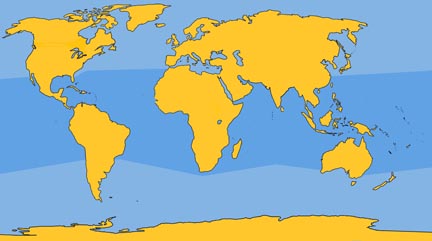Family: Delphinidae
Genus: Peponocephala
Species: P. electra (Gray, 1846)
When first described by Gray in 1846, the melon-headed whale was thought to be a member of the genus Lagenorhynchus. Since that time, however, no other specimen of Lagenorhynchus has been found that fits Gray’s description. In 1966, the animal was studied in Hawaii and placed in the genus Peponocephala, of which it is the only member. These dolphins were once thought rare, but sizable populations have been observed near the Philippines, and in the waters of Hawaii and Japan. In captivity, they seem to incite fear reactions in other dolphins. At sea from a distance, they are very difficult to distinguish from pygmy killer whales.
Physical Description: These animals have a slight indentation above the sides of the upper jaw, similar to that of false killer whales and pygmy killer whales, but there is no discernible beak. The tips of the upper and lower jaws are practically even, whereas the upper jaw obviously overhangs the lower in the pygmy killer whale.
Color: Dark gray over the entire body. The slightly darker saddle on the back extends down the sides from just forward of the dorsal fin. A thin white stripe runs along the upper and lower lips, and a white anchor pattern appears on the upper chest.
Fins and Flukes: The prominent dorsal fin is large, falcate, and located halfway down the back. Flippers are sickle-shaped, curved along the leading margins, and pointed at the tips. The flukes are well developed, pointed or slightly rounded at the tips, with a definite median notch.
Length and Weight: These animals reach at least 8 ft (2.6 m) and 400 lb (182 kg).
Teeth: 21 to 25 small, pointed teeth are found in each side of the upper and lower jaws.
Feeding: Known to feed on squid and small fish.
Breathing and Diving: They are known to jump completely out of the water as they swim and to ride the bow-waves of ships.
Mating and Breeding: Animals with newborn have been reported in the Southern Hemisphere during July and August, suggesting spring breeding.
Herding: They are known to herd in numbers of between 300 and 500.
Distribution: Tropical and temperate Atlantic, Indian, and Pacific oceans.
Migration: No information available.








